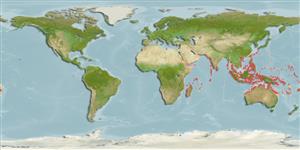Common names from other countries
Classification / Names / Names
Common names | Synonyms | Catalog of Fishes (gen., sp.) | ITIS | CoL | WoRMS
Environment: milieu / climate zone / depth range / distribution range
Ecology
Reef-associated; depth range 0 - 10 m (Ref. 122). Tropical; 30°N - 27°S, 32°E - 172°W (Ref. 107065)
Indo-Pacific, excluding Hawaii.
Length at first maturity / Size / Weight / Age
Maturity: Lm ?, range 16 - ? cm Max length : 40.0 cm TL male/unsexed; (Ref. 418); common length : 22.0 cm TL male/unsexed; (Ref. 122); max. published weight: 1.5 kg (Ref. 418)
Maximum total length: 35 cm, commonly 22 cm. Mean live weight: 300 g up to 1000 g (Ref. 122);1500 g (Ref. 418). Body-wall thickness: 0.6 cm. Body: oval, arched dorsally (bivium) and flattened ventrally (trivium). Bivium with characteristics wrinkles, covered by sediment when the animal is coming out of the bottom. Bivium with small papillae within black dots, and black podia ending in a disc of around 0.022 cm diameter; podia on trivium arranged irregularly, their calcareous disc around 0.035 cm in diameter. Mouth: ventral, surrounded by a collar of papillae and 20 grey, short and stout tentacles. Anus terminal, surrounded by a circle of 5 groups of radial papillae. Calcareous ring with a large medioventral radial piece. Cuvierian tubules absent. Color: highly variable; bivium whitish to dark brown, occasionally with dark transverse markings; trivium lighter, generally whitish. Spicules: very numerous; ventral tegument with tables and buttons, the tables having a moderately small disc, perforated by a varying number of holes of variable size, the spire with 4 pillars and a cross-like bridge, ending in a spiny crown with a hole in the middle; knobby buttons generally have 6 holes, occasionally more; small rods and denticulate plates also present; tables and buttons in dorsal tegument: tables with a nodose disc, much larger than in ventral tegument; buttons variable, larger, and more perforated than those in ventral tegument; ventral and dorsal podia with long and large spinose rods; tentacles with long spiny rods, small smooth rods, and large denticulate plates (Ref. 122).
Populations can reach high densities up to 1 per square meter. Provides the principal share of the tropical Indo-Pacific production of béche-de-mer and is harvested throughout the area in artisanal fisheries. Collected by hand while wading on the reefs at low tide. The processing method is particular of this species: the sea cucumbers are buried overnight, and the next day the numerous spicules are removed by brushing the tegument. The processed product is of major commercial value and at present highly demanded (Ref. 122).
Sexual reproduction takes place during warm season. A species with a high potential fecundity and early sexual maturity (Ref. 122).
Conand, C. 1998. (Ref. 122)
IUCN Red List Status (Ref. 130435: Version 2024-1)
CITES status (Ref. 108899)
Not Evaluated
Not Evaluated
Human uses
Fisheries: highly commercial
| FishSource |
Tools
Internet sources
Estimates based on models
Preferred temperature
(Ref.
115969): 25.8 - 29.3, mean 28.6 (based on 2941 cells).
Resilience
High, minimum population doubling time less than 15 months (K=0.52).
Vulnerability
Moderate to high vulnerability (53 of 100).
Price category
Unknown.
